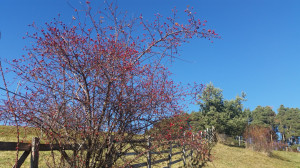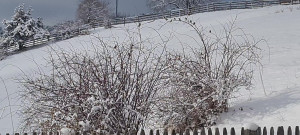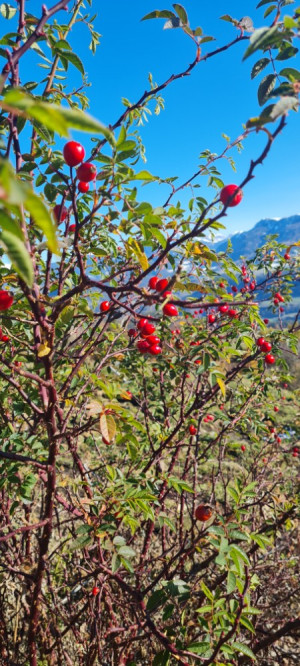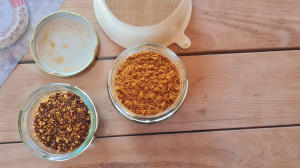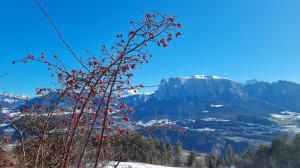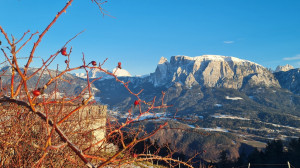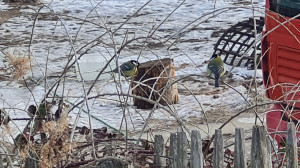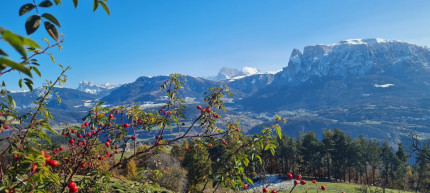
The rosehip is a fruit of the dog rose (Latin: Rosa Canina), a shrub several metres high that is not only native to us in Europe, but also to Asia and North Africa.
In South Tyrol it grows everywhere along forest edges, in hedges and on meagre pastures up to an altitude of about 1,300 metres above sea level - i.e. right on the doorstep of almost every farm. The rose blooms in June/July.
The doctors of classical antiquity had already included the dog rose, also called rosehip or "Hetschepetsch" in South Tyrol, in their medicinal treasure trove. The fruits of the dog rose were even found in the pile dwellings of the Bronze Age.
In autumn, from September to November the fully ripe red rosehip is collected, always leaving some for the birds. For them, the red capsules are a valuable source of nutrition for the winter.
Inside the rosehip, one finds numerous, small "false fruits", the nutlets (seeds). They are equipped with bristly hairs and can be used very well as itching powder. Who has not tried them or had to try them in their childhood?
To dry the rosehip, cut it open and remove the seeds. Drying should be quick, best in the oven, at 40 degrees. Even after drying, the rosehip contains a lot of vitamin C (much more than a lemon!), vitamin A, B 1, B 2, K and P, minerals, fruit acid, tannins and sugar. The seeds contain vanillin.
All these active ingredients make the rosehip a valuable fruit whose tea not only tastes pleasant, but also has a preventive effect, especially in times of colds. People with fever are refreshed and their defences are increased. In Bach flower therapy, dog rose is recommended for people who lack energy and are apathetic - it is said to restore vitality and joy.
A precious good is also obtained by pulverising the dried rosehips together with the seeds. It is good for the immune system and can help with arthritis. It tastes best in yoghurts, muesli, fresh salads, etc.
Ancient knowledge passed down through generations from nature, mostly from the farmers' wives, here are a few recipes of how rosehip tea is made here on the Ritten:
-2 heaped teaspoons of crushed rosehips are poured over ¼ l of boiling water and then left to infuse for 15 minutes.
The tea prepared in this way retains its full vitamin content for several hours, which makes it a recommended tea for the thermos flask.
A special tip from our neighbour, on whose farm a beautiful lime tree grows: she mixes lime blossoms in equal parts with rosehips - in this way, the active components of both medicinal herbs combine to make a particularly effective and pleasant-tasting tea. A mixture that should be used in times of the flu.
And this is how it is prepared:
-25 g rose hips with seeds
-25 g lime blossom
-2 heaped teaspoons of this mixture are then poured over ¼ l cold water, bring it to boil. Then leave it for 5 minutes- moderately warm, sweetened with honey and 1 teaspoon lemon, drink 1 cup of it in the evening.
In conclusion, as we have now come to know, the riddle in the song of the " A Man Stands in the Forest" is most probably solved, and it is thus about the bright red rosehip.
Grateful for all its beneficial properties, the rosehip, which grows right on our doorstep, is a great gift from nature to us all!
In South Tyrol it grows everywhere along forest edges, in hedges and on meagre pastures up to an altitude of about 1,300 metres above sea level - i.e. right on the doorstep of almost every farm. The rose blooms in June/July.
The doctors of classical antiquity had already included the dog rose, also called rosehip or "Hetschepetsch" in South Tyrol, in their medicinal treasure trove. The fruits of the dog rose were even found in the pile dwellings of the Bronze Age.
In autumn, from September to November the fully ripe red rosehip is collected, always leaving some for the birds. For them, the red capsules are a valuable source of nutrition for the winter.
Inside the rosehip, one finds numerous, small "false fruits", the nutlets (seeds). They are equipped with bristly hairs and can be used very well as itching powder. Who has not tried them or had to try them in their childhood?
To dry the rosehip, cut it open and remove the seeds. Drying should be quick, best in the oven, at 40 degrees. Even after drying, the rosehip contains a lot of vitamin C (much more than a lemon!), vitamin A, B 1, B 2, K and P, minerals, fruit acid, tannins and sugar. The seeds contain vanillin.
All these active ingredients make the rosehip a valuable fruit whose tea not only tastes pleasant, but also has a preventive effect, especially in times of colds. People with fever are refreshed and their defences are increased. In Bach flower therapy, dog rose is recommended for people who lack energy and are apathetic - it is said to restore vitality and joy.
A precious good is also obtained by pulverising the dried rosehips together with the seeds. It is good for the immune system and can help with arthritis. It tastes best in yoghurts, muesli, fresh salads, etc.
Ancient knowledge passed down through generations from nature, mostly from the farmers' wives, here are a few recipes of how rosehip tea is made here on the Ritten:
-2 heaped teaspoons of crushed rosehips are poured over ¼ l of boiling water and then left to infuse for 15 minutes.
The tea prepared in this way retains its full vitamin content for several hours, which makes it a recommended tea for the thermos flask.
A special tip from our neighbour, on whose farm a beautiful lime tree grows: she mixes lime blossoms in equal parts with rosehips - in this way, the active components of both medicinal herbs combine to make a particularly effective and pleasant-tasting tea. A mixture that should be used in times of the flu.
And this is how it is prepared:
-25 g rose hips with seeds
-25 g lime blossom
-2 heaped teaspoons of this mixture are then poured over ¼ l cold water, bring it to boil. Then leave it for 5 minutes- moderately warm, sweetened with honey and 1 teaspoon lemon, drink 1 cup of it in the evening.
In conclusion, as we have now come to know, the riddle in the song of the " A Man Stands in the Forest" is most probably solved, and it is thus about the bright red rosehip.
Grateful for all its beneficial properties, the rosehip, which grows right on our doorstep, is a great gift from nature to us all!
